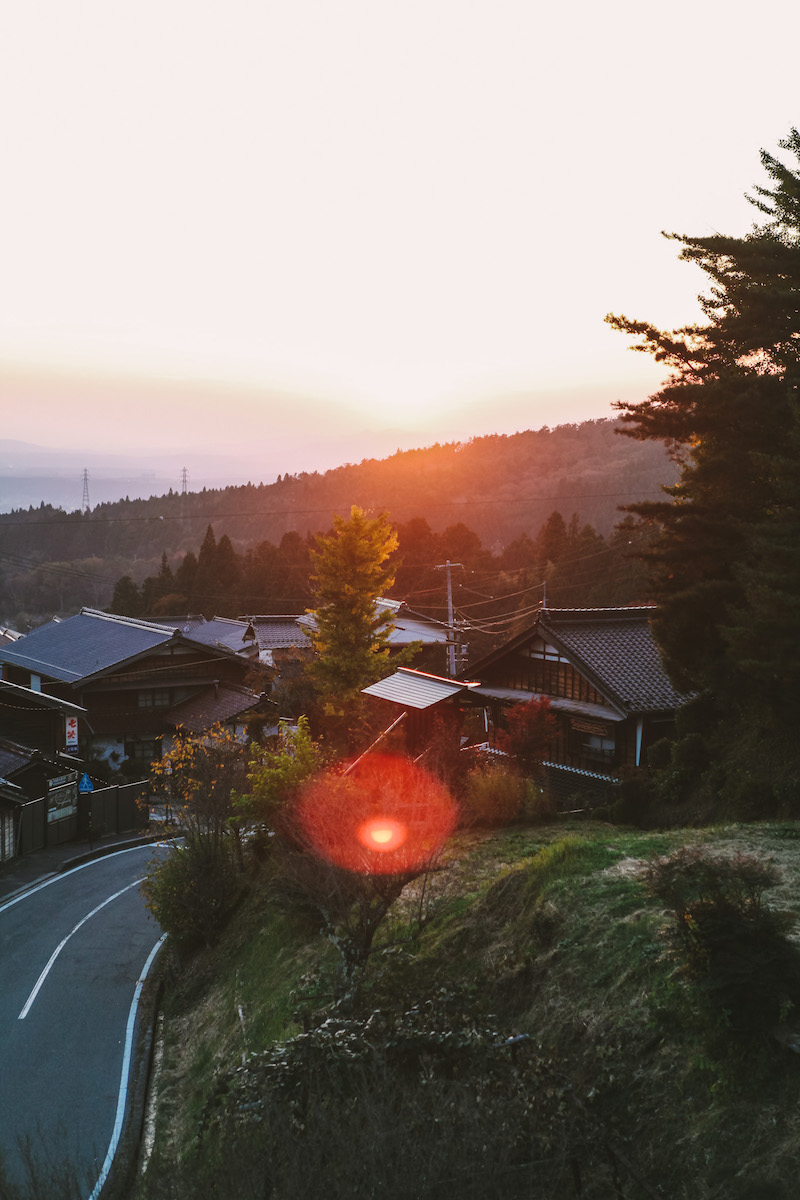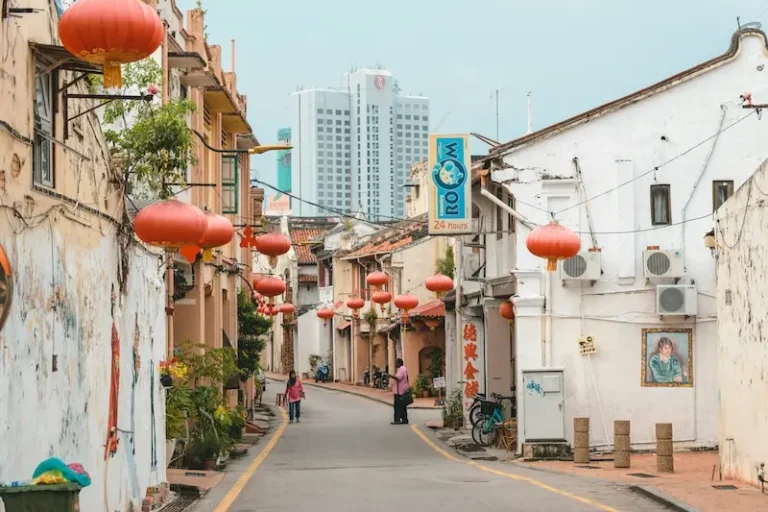TRAVEL GUIDE FOR MAGOME IN JAPAN [NAKASENDO]

WHAT ARE THE BEST THINGS TO SEE IN MAGOME? HOW TO GET TO MAGOME? HIKE FROM TSUMAGO TO MAGOME ALONG THE NAKASENDO WAY?
Magome is one of many villages along the Nakasendo way in Japan where you can still get a glimpse of traditional Edo-period architecture, and where you can imagine what village life was like in ancient Japan.
Magome is located in the middle of the beautiful Kiso Valley, in Gifu Prefecture, right between Kyoto and Tokyo and less than 100km east of Nagoya.
From Magome, it is possible to hike on the Nakasendo Way to the neighboring village of Tsumago.
A bit further north you will find another beautiful and well-preserved village: Narai Juku.
In the Kiso Valley, Magome Juku is one of the most authentic villages because it is almost entirely made up of traditional wooden houses dating originally from the 18th century.
The path that crosses Magome is called the Kisoji and connects the 11 villages of Nakasendo grouped in the Kiso Valley. The most beautiful villages on this path are Magome, Tsumago or Narai.
Have you heard of the Nakasendo Way?
The Nakasendo Way is an ancient route in Japan that connects Kyoto and Tokyo. It was one of the five routes of the Edo period, and it runs through the central mountains of Japan.
This route was popular among travelers such as the Samourai during the Edo period. Along the Nakasendo Way, travelers would encounter post towns such as Magome, Tsumago, and Narai-Juku, where they could rest, eat, and find lodging for the night.
HERE IS SNEAK PEEK ABOUT MAGOME IN JAPAN:
GUIDE TO MAGOME, A POST TOWN ON THE NAKASENDO WAY,

The Nakasendo is an old road linking Edo (Tokyo) to Kyoto.
It had 69 stations (juku) over more than 500 km. Today, it is a popular hiking trail that is accessible to all. By the day or over several days, enjoy the most unspoiled portions of the Kiso Valley, bucolic landscapes, and charming mountain villages with wooden houses.
Lords, samurai, porters, merchants, etc. used the Nakasendo for centuries.
We first learned about Nakasendo while watching a documentary about Joanna Lumley in Japan. You can find it on Netflix.
Watching this documentary before your trip to Japan would be a very good idea!
READ: HIKING GUIDE FOR NAKASENDO WAY
WHAT TO EXPECT IN MAGOME?
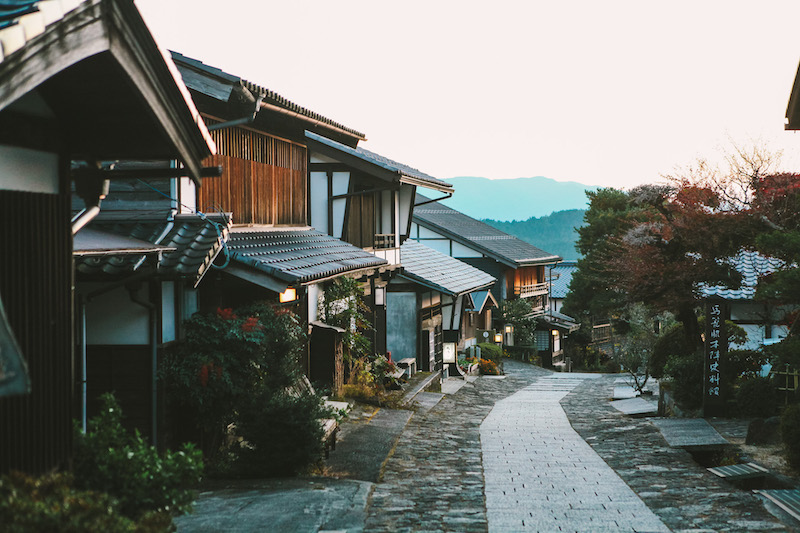
Magome is now essentially a succession of shops, boutiques, restaurants and Ryokans (Japanese traditional accommodation).
It is a very touristy village. However, the visit is very pleasant and one of the best things to see along Nakasendo!
The village is completely uphill. Indeed Magome was built on the mountainside. So be prepared for an ascending walk to reach the top of the village!
Actually, we recommend starting from the top of the village at the viewpoint (here). From there you can simply go down the main alley, which would require much less effort 🙂
BEST THINGS TO SEE IN MAGOME?
1. Stroll through Magome’s main alley

Like in most post towns along Nakasendo, the main alley is the most important attraction! Take your time to stroll through Magome’s main alley. There you will find most shops, restaurants, and ryokans.
Just imagine what it must have been like at the time of Samurais crossing the village hundreds of years ago. Fascinating!
2. Visit Magome Waki-Honjin Museum

Opposite the tourist office is the Wakihonjin Museum in which the history of the village is explained.
The museum is open from 9:00 a.m. to 5:00 p.m.
3. Visit Honjin/Tozon memorial
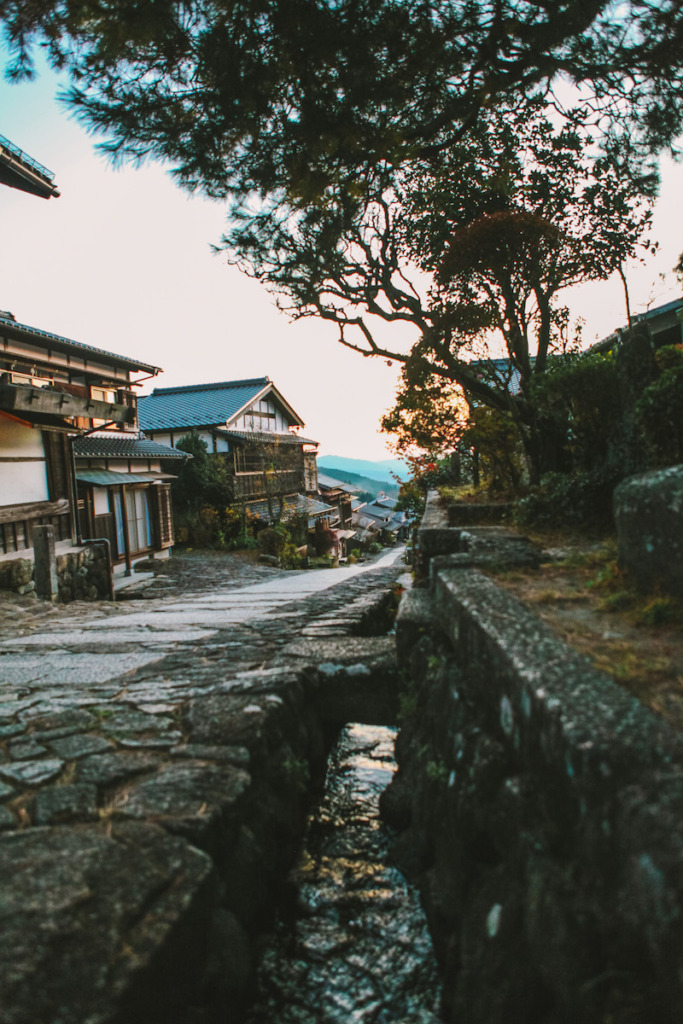
Right next to the museum is the Honjin/Tozon Memorial. it is also the former residence of the writer Shimazaki Toson, now a museum.
It is open from 9:00 a.m. to 5:00 p.m.
4. Take a break at Cafe Kappe
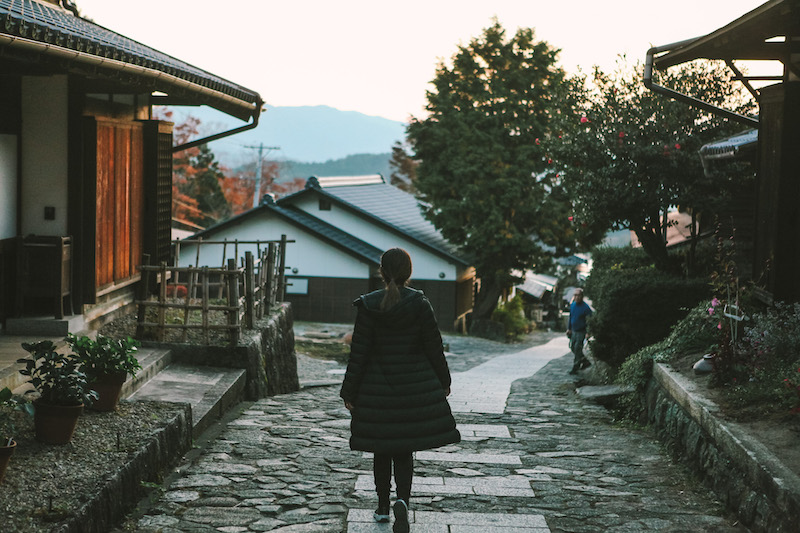
Along the main road, stop at Cafe Kappe. From the terrace, the view is stunning!
5. Enjoy the view at Magome’s Lookout


For the best view of the village and the surrounding mountains head to the lookout at the top of the village. The viewpoint is in the direction of Tsumago, the next posttown after Magome.
This place is named Magome Miharashidai. There are a few stone stelae, benches, and one or two small shelters.
Location: here
6. Take a photo of Magome’s scenic Watermill

One of the most emblematic images of Magome is the watermill at the entrance to the village. It is possible to visit the interior of the house attached to it for free.
7. Visit Eishoji temple

The Eishoji temple (永昌寺) which dates from 1558 houses a statue of Kannon sculpted by Enku (円空).
Also made famous by one of Tôson Shimazaki’s novels, this temple all offers the possibility of sleeping in a temple and/or tasting Buddhist temple cuisine: Shojin Ryori (精進料理).
Location: here
8. Magome Notice Board

At the exit from Magome in the direction of Tsumago you will find the traditional Kosatsuba (高札場). This large board where signs are displayed that were used by the government to announce important news.
As in 1711, when the hunt for Christians began with bounties. It is also this year’s panels that have been chosen to be displayed again.
Useful information about Magome
When is the best time to visit Magome?

Like the rest of Japan, Magome is most beautiful during the spring season (March to May) and in the fall (September to November) when the rich foliage is full of colors.
READ: WHEN IS THE BEST TIME TO VISIT JAPAN?
How to get to Magome?

Depending on where you come from there are different possibilities to get to Magome.
If you come from Tsumago, then we highly recommend hiking to Magome. This is one of the best hikes throughout Japan! It takes 3 hours. More about it later in this post.
If you are staying in Nakatsugawa, you can take the bus from Nakatsugawa Train Station on the Magome Line (get off at the Magome stop). You can also take a taxi, it will take 20 minutes.
From Tokyo, you will need to reach Nakatsugawa by train first before heading to Magome.
Remember to buy your JR PASS when traveling by train to Japan, you will save lots of money! BUY IT HERE.
HOW TO GET AROUND?
The good news, it’s all within walking distance. You can visit Magome on foot.
WHERE TO STAY IN MAGOME?
Why not stay overnight in Magome? After 5 pm you will have the entire place more or less to yourself as all tourists tend to leave before 5 pm.
There are a few options in Magome.
Magome Chaya

Magome Chaya offers comfortable rooms in a traditional Ryokan. From the guest house you will have a fantastic view of the surrounding mountains. The Ryokan serves breakfast and dinner. The owners are also very friendly! BOOK HERE
Tajimaya

Tajimaya is another wonderful Ryokan in Magome. This is the quintessential Japanese-style traditional inn experience. You can also expect delicious food! BOOK NOW
OTHER THINGS TO SEE NEAR MAGOME
Narai-Juku
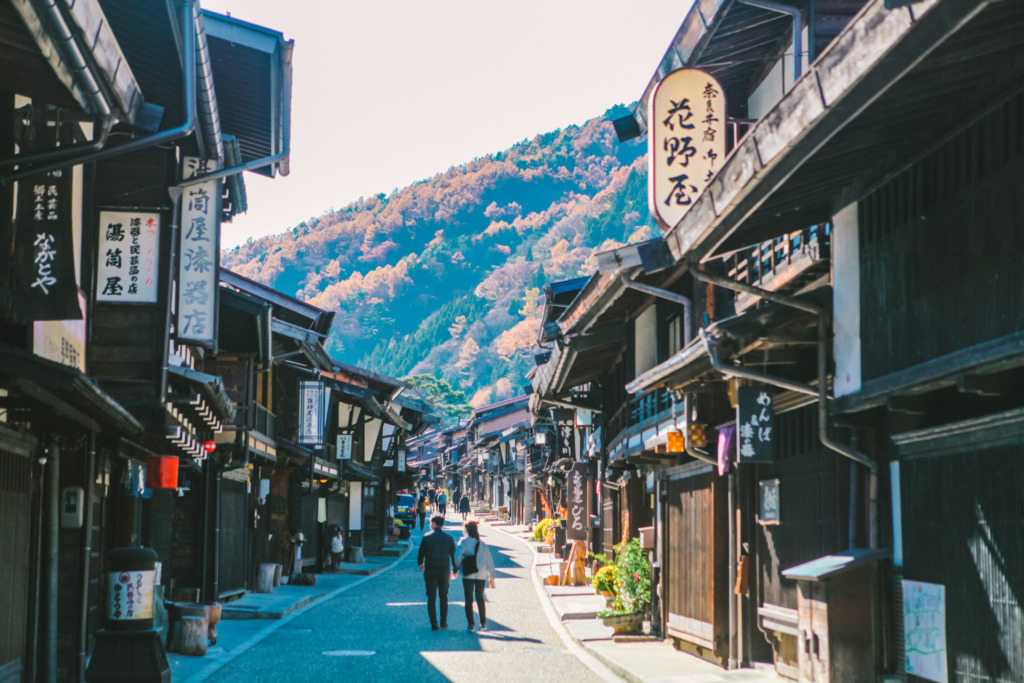
Discover a well-preserved heritage former post town on the famous Nakasendo Way! Narai-Juku, located in the beautiful Kiso Valley, is perhaps less well-known than Tsumago and Magome which are on the same historical path. However, it is one of the most beautiful places along the Nakasendo Way!
Our visit to Narai-Juku was magical! We felt transported to the past, during one of the most beautiful eras of Japan! We absolutely love Narai-Juku and highly recommend that you stop by for a visit.
READ: FULL GUIDE FOR A VISIT TO NARAI-JUKU
Tsumago
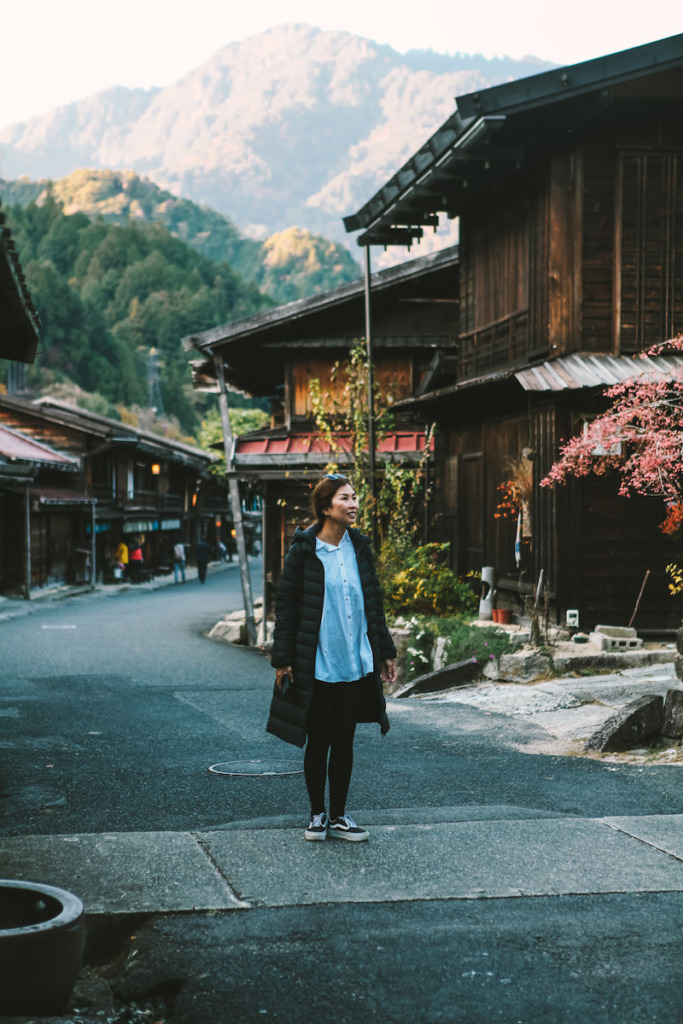
When you arrive in Tsumago another beautiful post town along Nakasendo, time seems to rewind and you rediscover all the charm of ancient Japan. The dark wooden buildings stand tall. Shrubs line the narrow streets. No telegraph pole or television antenna in sight.
The government has made it a point of honor to preserve a traditional decor, authentic as in the time of the lords who visited it hundreds of years ago.
For us Tsumago, along Narai Juku and Magome are the most charming post towns along Nakasendo! The 3 of them are a must-see if you visit this part of Japan!
READ: FULL GUIDE FOR A VISIT OF TSUMAGO
HIKE BETWEEN TSUMAGO AND MAGOME

The 8 km that separate the two jukus run through the forest on partially paved paths. Count 3 hours to reach Magome from Tsumago or vice versa.
From Magome, just after the summit, an old tea house (一石栃立場茶屋) on the side of the path displays tools from the Edo period. At cherry blossom time, the old weeping cherry tree on the other side turns a vivid pink, while the park below serves as a picnic break.
Then the path begins to descend among the pines and cypresses of Kiso.
On the road, you will also find a tomb dedicated to a 16th-century samurai. The story goes that the latter sacrificed his life to protect a hamlet from a gang of bandits.
The Odaki-Medaki waterfalls (男滝女滝 (雄滝雌滝), in addition to being photogenic, also invite you to take a moment to contemplate them. Small landscaped paths make it easy to reach their foot and for the more adventurous to swim.
This is one of the most scenic trails in Japan! Don’t miss it!
READ: FULL GUIDE FOR HIKING ALONG NAKASENDO
Kiso Valley

The Kiso Valley lurks along the Japanese Alps and the Kiso River, between Nagano Prefecture and Gifu. Its secular atmosphere contrasts with the wild authenticity of its landscapes, an ode to time travel for visitors.
Between imposing cliffs, the Kiso Valley stretches 52 km from east to west and 63 km from north to south. Its landscape dominated by lush vegetation and majestic mountains is a real natural treasure.
The valley is crossed by the old trade route of Nakasendo. The Kisoji section, which stretches for a distance of 70 km.
The Kiso Valley is home to around 11 towns called “juku” or post towns whereby Magome, Tsumago, and Narai are the best preserved.
Final thoughts – Is Magome worth a visit?

After reading this post, you probably know the answer already! Magome is absolutely worth a visit!
A post town resulting from the old road system, which preserves the atmosphere of the Edo period. A walk on the paved road
will make you feel like a traveler from the ancient world!
The Nakasendō is an old road that connected Tokyo to Kyoto, along which were placed many stopover towns, places where travelers could spend the night. Magome is one of them!
The steep terrain of Magome makes it a unique stopover town in the country. It is said that the name Magome (written with the characters “horse” and “basket”) comes from the fact that travelers had to leave their horses at the inn because of the difficulty of the path, which the horses could not ride.
On either side of the stone-paved streets, lined latticed houses, museums, tea rooms, and souvenir shops: a landscape evoking the old Edo period staging town, centuries ago.
Spending the night at one of the post towns along Nakasendo is also a magical experience! When night falls, the lamps in front of each house are lit, creating a truly charming landscape.
We hope that you found this post useful to help you prepare for your trip to Japan. We wrote many other posts about Japan here.
Related posts
- GUIDE FOR A VISIT TO NARAI-JUKU
- HIKE ALONG NAKASENDO [TRAVEL GUIDE]
- GUIDE TO TSUMAGO ALONG NAKASENDO
- 15 BEST THINGS TO SEE IN TAKAYAMA
- 15 BEST THINGS TO SEE IN HAKONE NEAR MT. FUJI
- 15 INCREDIBLE THINGS TO SEE AT LAKE KAWAGUCHI
- OBUSE, A BEAUTIFUL TOWN IN JAPAN WORTH A VISIT
- 10 BEST THINGS TO SEE IN MATSUMOTO
- FULL GUIDE FOR VISITING HAKUBA IN JAPAN
- DISCOVER LAKE YAMANAKA NEAR MT. FUJI

